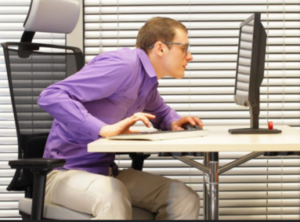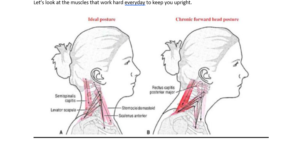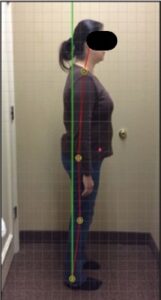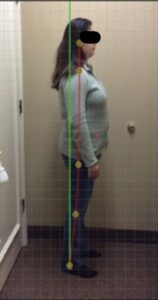Momma was right! Your posture really does matter! Posture as the cause of headaches…really??
How many times did your mom yell at you to “sit up straight!”? It’s a memory that is still burned into my brain to this day. However, posture is so much more than looking good and feeling confident, it can really mess up your day should it be the cause of those nagging, production sabotaging, mood wrecker pounding headaches. In today’s world of tech, sitting now is the norm and walking has become a chore. We are chained to our desks while we toil away on our computers and then we are beholden to every buzz and ring of our cell phones—forward head posture is now the result of this necessary evil and dare I say, obsession. There is actually a diagnosis code given to this escalating problem in which they label it “text neck” a concept conceived originally by conceived by Dr. Dean L. Fishman, D.C.. This goose-neck posture is now the dominating stance among the majority of our advanced civilization.
Does this look familiar:
A recent study shows that nearly 80% of the population between ages 18 to 44 keep cell phones with them almost every waking minute. Most estimates showing only having two hours a day without their phone in or near their hands. The stress of constantly looking down at a phone or device creates a dangerous condition known as “tech neck”. Body and spinal design do not come equipped with enduring the constant and sustained neck pressure. (1)
Whether it’s incessantly checking our phones or sitting at our desks for eight to ten hours straight, forward head posture may be a common cause of headaches. A recent systematic review done in Hong Kong suggests that the prevalence of musculoskeletal problems with mobile phone usage are high ranging from17.3% to 67.8% for neck complaints. (1)
Let’s look at the muscles that work hard every day to keep you upright.
Honestly, just looking at this picture gives me a headache! Take a look at the bright red area on the back of the neck. Ask yourself, do your headaches typically start in the back of your neck/head and travel forward giving you the throbbing tension headache that becomes a day-wrecker? If you said a resounding “YES!”, then it’s quite possible text/tech neck or a chronic forward head posture is the bane of this miserable malady.
But, this doesn’t just end at headaches and neck pain, oh no! This issue is a literal domino effect that will eventually affect your entire spine and body. I typically refer to this effect as “The Curse of the Biped”. Why? Because, as homo sapiens we need to maintain continuous balance on all sides of our bodies to remain upright and balanced on two feet. Should an imbalance occur, we have to chronically compensate for fall down. This balancing act occurs during our entire waking day, whether we are sitting or standing—the balancing act is constantly making subtle compensations—tightening this muscle here or relaxing this muscle there to try and maintain this upright position.
Why does bad posture cause headaches?
When the head moves in forward extension, away from the neutral and balanced position, a heads effective weight feels as if it has doubled. “For every inch of Forward Head Posture, it can increase the weight of the head on the spine by an additional 10 pounds.” (2). Forward head posture is becoming an epidemic with the ever growing use of technology in the form of cell phones, laptops, tablets and personal computers. Of particular importance is this syndrome in young children and adolescents has been shown to be associated with “cervical degeneration along with other developmental, medical, psychological, and social complications”. (3) This can lead to significant increases in neck and back pain in the modern world significantly affecting the overall health of both children and adults.
As a chiropractic office, we see this issue day in and day out. So, as part of a curiosity as well as a requirement to complete my studies to obtain my Diplomate of Chiropractic in Craniocervical Junction Procedures through the International Chiropractic Association Upper Cervical Council, I set out to see how the Orthospinology procedure (the upper cervical chiropractic technique utilized at HealthWorks) affected forward head posture. Much to my delight (frankly, I didn’t want to have to find another study design with a deadline lurking), the results were not only showed a positive correlation, but statistically significant as well—which is uber important in any study design!
Synopsis of the Study: Methods, Setting and Participants
A paired group study was performed which included 50 participants who were new patients from one private chiropractic clinic. Patients were ranging in age from 7 to 76, with 76% being female and 24% being male. The outcome assessed pre and post effective head weight following a specific correction of established craniocervical junction misalignment.
The human head weighs around 10 pounds and represents 8% of the total body mass as determined by researchers at the Department of Anatomy & Histology, University of Sydney. An ideal posture is when the tragus of the ear is positioned vertically above the acromion process; the head is then perfectly balanced. The PostureScreen Mobile Application uses a patient’s total body mass and determines the patient’s actual head weight using this calculation. (4)
For the purposes of this study, a lateral digital picture was taken using the PostureScreen Mobile Application with an Apple iPad. In order to account for the natural visual correction of posture (4), participants were asked to close their eyes, flex, extend and rotate their head from left to right and return to what they believed to be center without opening their eyes. Five anatomical landmarks were plotted to note lateral posture abnormalities. These landmarks included the tragus of the ear, acromion process of the shoulder, the lateral trochanter, lateral knee at the tibial tuberosity and lateral malleolus. The application then calculated the patient’s actual head weight and effective head weight due to the forward head posture presented. Effective head weight is physiologically significant because “For every inch of Forward Head Posture, it can increase the weight of the head on the spine by an additional 10 pounds.” (2)
Intervention Along with receiving a postural assessment on the first day of presentation, they also received a complete set of orthogonal films and analysis which “analyzes the relative positions of the occiput, atlas, and axis…demonstrating signs of a chiropractic subluxation from their evaluation” (5). The set of films included a lateral cervical neutral, nasium, and vertex views. “Radiographic examination of these structures confirms presence of misalignment allowing each adjustment to be specifically tailored using the patient’s osseous measurements”. (5) On a separate visit, the specific correction was made using Orthospinology procedures to procure the coordinates or “listing” found during the analysis. This listing determines the specific vectors needed to correct the CCJ misalignment specifically designed for each patient.
The correction was made using a KH-2 Laney, handheld adjusting instrument. A stylus was placed on the lateral neck at the transverse process of the atlas, with the patient lying on their side. The positioning of the patient and the line of drive, lateral to medial and the specific vectors used were calculated using the listing mentioned previously from the Orthospinology procedures x-ray analysis. (5)
A new postural evaluation was then made using the PostureScreen Mobile application, following the correction.
Results Among the 50 participants, pre- to post-effective head weight decreased (mean = 30.5 lbs vs. 24.9 lbs, difference = 5.6 lbs; 95% CI 2.0, p<0.05 P(T<=t) two-tail 4.78197E-05). The result included all 50 participants, as the exclusionary measures were taken into account prior to the calculations being obtained. Discussion This study was not undertaken as merely a curiosity, but to determine whether a specific, gentle intervention regarding the correction of a CCJ misalignment, could possibly play a significant role in the initial treatment of forward head posture, as this postural abnormality is also associated with more than just neck, back or spinal pain, but other comorbidities like chronic posture-induced headaches that is a burden on individuals and families at home and in the workplace. Further research and case studies regarding forward head posture and Migraines and Headaches According to the CDC, 14.2% of adults suffer from migraine or severe headache over a 3 month timeframe. Approximately 37 million people suffer from migraines in the United States alone and it’s the 4th leading cause of an emergency room visit, with women in childbearing age being more affected than men (6).
In a case study, involving a 56 year old male, presented with “severe forward head translation of the head”, and following a course of chiropractic care and myofascial release for a period of 7 months, his headaches did not recur and he also showed improvement on x-ray in regards to the previously noted forward head posture. (7)
In another indexed study, 20 participants with unilateral migraine, along with 20 controls, migraine sufferers “showed a smaller cranio-vertebral angle than controls, thus presenting a greater forward head posture”. (8)
How do you get rid of posture headaches?
Conclusions Specific correction of CCJ misalignment shows a positive initial impact on combating the epidemic of forward head posture which could lead to decreasing its noted complications in modern human health. Future studies are warranted that should include a larger cohort, multiple clinics, continued monitoring of progress while under care for a longer period of time, along with added beneficial exercises. This could further determine the significance of the postural changes and its effectiveness in decreasing the health implications associated with forward head posture.
This inter-office study is just one of the many ways HealthWorks looks deep into the cause of headaches and other Musculo-skeletal issues that can really affect the daily lives of the community. Upper cervical chiropractic care may be just the hope and help you need! Let us help you find out!
References:
1) International Journal of Community Medicine and Public Health Samani PP et al. Int J Community Med Public Health. 2018 Aug;5(8)
2) Kapadndji, A.I., The Physiology of the Joints: The Spinal Column, Pelvic Girdle and Head, Vol.3, 6th Edition, Churchill Livingstone, 2008
3) Vate-U-Lan, P., (2015). Text Neck Epidemic: a Growing Problem for Smart Phone Users in Thailand. International Journal of the Computer, the Internet and Management Vol 23 No. 3 (September-December) pp. 27-32.
Retrieved from: http://www.ijcim.th.org/SpecialEditions/v23nSP2/02_55A_Epidemic.pdf
4) Boland, D.M., Neufeld, E.V., Ruddell, J., Dolezal, B.A., Cooper, C.B., Inter- and intra- rater agreement of static posture analysis using a mobile application. J Phys Ther Sci. 2016 Dec; 28(12): 3398-3402 [Pubmed]
5) Rochester, R.P., Neck pain and disability outcomes following chiropractic upper cervical care: a restrospective case series. J Can Chiropra Assoc. (2009) Aug; 53(3): 173-185 [Pubmed].
6) Lee, W.Y., Okeson, J.P., Lindroth, J., The relationship between forward head posture and temporomandibular disorders. J Orofac Pain, (1995) Spring;9(2): 161-7. [Pubmed]
7) Gadotti, I.C., Berzin, F., Biasotto-Gonzalez, D., Preliminary rapport on head posture and muscle activity in subjects with class I and II., J Oral Rehabil. (2005) Nov;32(11): 794-9. [Pubmed]
8) Burch RC1, Loder S, Loder E, Smitherman TA., The prevalence and burden of migraine and severe headache in the United States: updated statistics from government health surveillance studies. Headache. 2015 Jan;55(1):21-34. [Pubmed].






